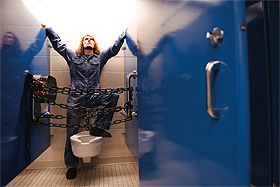News Archives - 2009
"Urinetown: The Musical" explores corporate abuse of power
 Due to an overwhelming response, tickets for Augsburg's production of Urinetown: The Musical sold out the week before the show's opening. Tickets may be available in the unclaimed ticket line prior to each performance. Call 612-330-1257 for information.
Due to an overwhelming response, tickets for Augsburg's production of Urinetown: The Musical sold out the week before the show's opening. Tickets may be available in the unclaimed ticket line prior to each performance. Call 612-330-1257 for information.
Director's Notes
Since its opening in September 2001, Urinetown: The Musical has been produced in professional, educational, and community theatres all over the country. The Broadway production received Tony Awards for Best Director, Best Original Score, and Best Book of a Musical.
Creator Greg Kotis originally conceived of Urinetown: The Musical while visiting Europe in 1995. With $300 in his pocket, he and his girlfriend planned to explore Paris on a two-week layover while on their way back from performing in Eastern Europe. Their lack of funding made the couple conserve at every turn by sleeping and eating for as little money as they could. They continually searched for the most inexpensive pay-per-use toilet facilities that they could find.
According to Kotis' account in a 2003 American Theatre article, it was this trip that spurred the original concept for Urinetown. While searching for amenities in Paris, he imagined a story about a business, Urine Good Company, that monopolizes all of the toilets in the city by paying off government officials. By exploiting the demand (all humans need to use a bathroom) and controlling the supply (few poorly maintained public toilets), Urine Good Company raises the fee for use, becoming so extremely powerful and wealthy that the people have no other recourse but protest.
Stylistically, Urinetown draws from various genres in American musical theatre. The musical numbers range in style from romantic love songs a la Rodgers and Hammerstein to the overt, hard-edged quality associated with Kurt Weill. While Urinetown draws on extreme theatricality, it's the work's political underpinnings that have struck a chord with audiences. It uses a traditionally enjoyable form like the American musical theater but illuminates serious issues like the sustainability of resources. What seems to be a contradiction instead resonates and reinforces the importance of the subject matter.
As a cast, we've become aware of how the musical also echos America's recent credit crises and the various real-life characters involved. We've noted the similarities between the corrupt actions of Urine Good Company and the credit scandals revealed in recent news stories. Throughout six weeks of rehearsals, we've discussed stories of executives flying expensive private jets to Washington to request bailout money and channel it into large bonuses, comparing their choices to some of the contemptible actions of Caldwell Cladwell, CEO of Urine Good Company. We've laughed about the parallels but found them astonishing, too.
–Darcey Engen
Design Notes
In an effort to responsibly utilize resources both natural and fiscal, the Theatre Department's goal for the scenery and costume construction for this production of Urinetown: The Musical was to recycle materials from previous productions and try to purchase as little new raw material as possible. Many of the costumes have been pulled for various storages and altered to meet the needs of the design. The scenery has been built with materials saved from 11 previous sets dating back ten years.
The main steel walls have now had three lives. The panels were originally a railroad fence in Northeast Minneapolis before finding their way into our Machinal set five years ago. The stairs both on stage and offstage were originally built for Romeo and Juliet and Buried Child. All of the platforms were built from materials saved from the remains of our winter production of Eleutheria. The bricks were made from the paper product homosote, which originally had been used as the pool underlayment for the recent production of Eurydice. Other materials were recycled from The House of Atreus, Blood Wedding, Life is a Dream, and Top Girls. A variety of new steel materials had to be utilized to create the tunnels, and a few new pieces of pine and lauan were needed to build the under structure for the arches.
–Michael Burden